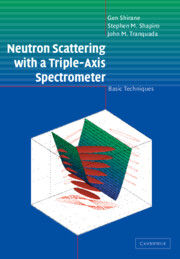Book contents
- Frontmatter
- Contents
- Preface
- 1 Introduction
- 2 Scattering formulas
- 3 Elements of a three-axis instrument
- 4 Inelastic scattering and the resolution function
- 5 Phonons and magnons
- 6 Spurious peaks
- 7 Bragg diffraction
- 8 Polarized neutrons
- Appendix 1 Neutron scattering lengths and cross sections
- Appendix 2 Crystallographic data
- Appendix 3 Other useful tables
- Appendix 4 The resolution function for a triple-axis neutron spectrometer
- Index
1 - Introduction
Published online by Cambridge University Press: 19 August 2009
- Frontmatter
- Contents
- Preface
- 1 Introduction
- 2 Scattering formulas
- 3 Elements of a three-axis instrument
- 4 Inelastic scattering and the resolution function
- 5 Phonons and magnons
- 6 Spurious peaks
- 7 Bragg diffraction
- 8 Polarized neutrons
- Appendix 1 Neutron scattering lengths and cross sections
- Appendix 2 Crystallographic data
- Appendix 3 Other useful tables
- Appendix 4 The resolution function for a triple-axis neutron spectrometer
- Index
Summary
In this introductory chapter we discuss some of the properties of the neutron and how it interacts with matter. We compare steady-state reactors to pulsed spallation neutron sources. After a review of the scattering geometry of an experiment we discuss the various instruments used for inelastic scattering.
Properties of thermal neutrons
The neutron is an ideal probe with which to study condensed matter. It was first discovered in 1932, and four years later it was demonstrated that neutrons could be Bragg diffracted by solids (see Bacon, 1986). The early experimenters struggled with the low flux from Ra–Be sources but, nevertheless, established the fundamentals of neutron diffraction. The future was assured by the construction of the first “atomic pile” by Fermi and his co-workers in 1942. Subsequent reactors produced more and more neutrons and the latest generation of high-flux reactors built in the 1960s and early 1970s produce a copious number of neutrons, making inelastic scattering studies practical. It is now widely accepted that neutron scattering is one of the most important and versatile techniques for probing condensed matter. This fact was recognized by the awarding of the Nobel Prize in Physics in 1994 to Profs. C. Shull of Massachusetts Institute of Technology (MIT) and B. Brockhouse of McMaster University (Canada) for their seminal contributions to the fields of elastic and inelastic neutron scattering. Arguably the most important instrument used in neutron spectroscopy is the triple-axis spectrometer (invented by Brockhouse, 1961) since it allows for a controlled measurement of the scattering function S(Q, ω) at essentially any point in momentum (ħQ) and energy (ħω) space.
Information
- Type
- Chapter
- Information
- Neutron Scattering with a Triple-Axis SpectrometerBasic Techniques, pp. 1 - 19Publisher: Cambridge University PressPrint publication year: 2002
